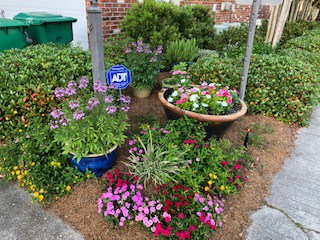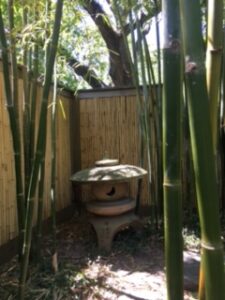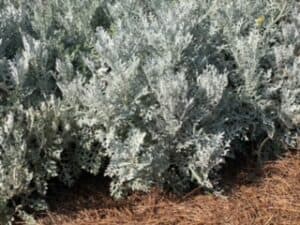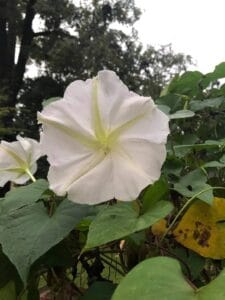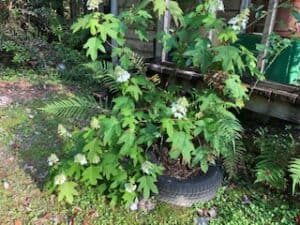(Image above: Decorative Pots in garden, K. Blackburn)
In the Garden Zone
Gardening offers many options to create relaxing green spaces. Whether you have a great deal of land to create sprawling gardens, or you are working with a small patio, a well though out design can help make useful and unique outdoor spaces.
According to Garden Media’s 2022 Garden Trends Report, people are creating “zones” for optimal use of space. There are many ways to build zones, from container planting and window boxes to carefully placed outdoor furniture – and even outdoor paintings and curtains.
Zoning areas of the garden or landscape: Butterfly Garden, Community Garden, Container Garden, Cut Flower Garden, Demonstration Garden, Edible Garden (Fruits, Herbs, & Vegetables), Fairy Garden, Hedge Garden, Indoor Garden, Kitchen Garden, Moon Garden, Organic Garden, Pollinator Garden, Rose Garden, Sensory Garden, Succulent Garden, Tire Garden, Therapeutic Garden, Tropical Garden, and Vertical Garden.
Patio areas that provide seating and outdoor décor can extend the square footage of your home, giving you more areas to entertain and relax. You also can create sitting areas in your landscapes with different zones and themes.
Pollinator gardens are another great addition. Lucky for us, the plants that pollinators love to visit are some of the most beautiful ones we can add to our gardens. Many types of both annual and perennial color add beauty to the garden and draw in some of nature’s most graceful creatures.
Cottage gardens are quaint with colorful plants. These gardens usually include a wide variety of colorful ornamental plants alongside edible plants and herbs all mixed together. Cottage gardens are charming and often feature white picket fences, arbors, clay pots and delicate signs. They are a relaxed play on more traditional gardens and can have the tendency to spill over into other aspects of the landscape such as paths and lawns, creating a continuation of space.
Image above: Cottage garden, K. Blackburn
Cut Flower Gardens provide fresh flowers for bouquets, greenery and fillers for arrangements and pollinator interest. Some recommendations; Ageratum, Allium, Asters, Black-eyed Susan, Cone Flowers, Daffodils Dahlias, Daisies, Delphinium Dianthus Foxglove, Gladiolus, Hydrangea, Lavender, Liatris, Mums, Roses Salvias, Snapdragons, Sunflowers, Tulips, Yarrow, Zinnias.
Images: (left) Zinnia for cutting, K. Blackburn; (right) Angelonia, K. Blackburn
Moon gardens are enjoyed at night and defined by the type of plants they include — typically, plants with white or cool-colored flowers in addition to silver or variegated foliage that can be seen in the reflected light of the moon. Cool colors such as light blue, bright yellow, chartreuse and lavender in addition to white flowers and gray and silver foliage can be more easily seen at nighttime in the garden. Moon gardens also can include flowers with heavy evening fragrance as well as light-colored hardscapes and accessories that enhance the garden at night.
The science behind moon gardening is that our eyes have limited vision of colors and contrast in the dark. However, the color white stands out in the darkness and often gives off a glowing light. Also, our senses are naturally heightened after dark to the sights, smells and sounds of the night. Start with selecting plants with white or cool-colored flowers that show up best against a dark background. Incorporate a mix of plants with dark foliage to provide a backdrop.
You can enhance your moon garden by adding light-colored planters and white trellises or lattices that support climbing vines such as fragrant white jasmine. Use light-colored gravel and walking stones for pathways and solar lights to help illuminate them. You can also incorporate lanterns, soft string lights and candles. Choose a site in the landscape that is easily accessible and open for stargazing, allowing moonlight to illuminate the gardens.
Images: (left) Dusty Miller, Heather Kirk-Ballard; (center) Moon Flower, Christie Russell; (right) Tire Garden (Oakleaf hydrangea) K. Blackburn
Moon garden plant suggestions: moonflower (ipomea alba), Serena White angelonia, Infinity White New Guinea impatiens, Japanese painted fern, Ghost painted fern (Athyrium niponicum pictum), Jack Frost brunerra (Brunnera microphylla), Silver Sceptre and Ice Dance Carex morrowii, Silver Carpet Stachys byzantinia, Silver Falls Dichondra argentea, Diamond Frost euphorbia, Lobelia siphilitica, four o’clocks and morning glories. Trees with white or light-colored bark such as river birch (Betula nigra) also can show up well at night and provide some height in the landscape.
Sensory Gardens can be achieved by using plantings of varied textures and sizes. Use plants without sharp features that can be touched and rubbed against such are herbs. Fragrant trees, plants and shrubs such as roses and herbs, grasses that rustle and make sounds in the wind. Add water through a pond or small water features even bird baths. Crushed rocks and varied paths may enhance a sensory garden. Use art, wind chimes, pottery and statues to make the area personal.
No matter what type of area you wish to create, there is a plant perfect for that zone. In addition, containers help expand the limits of your space and make it possible to include most any type of plant you wish to highlight.
*Information from Presentation to MGGNO and articles by LSU Agcenter Horticulturist Heather Kirk-Ballard

By Karen Blackburn

